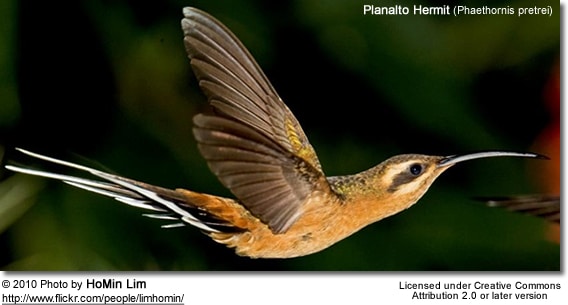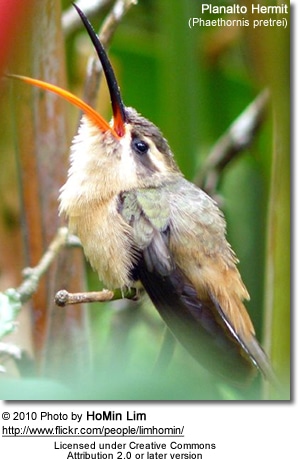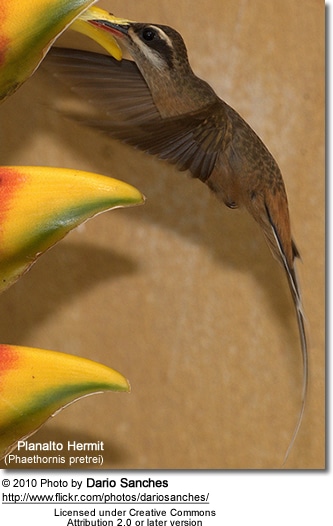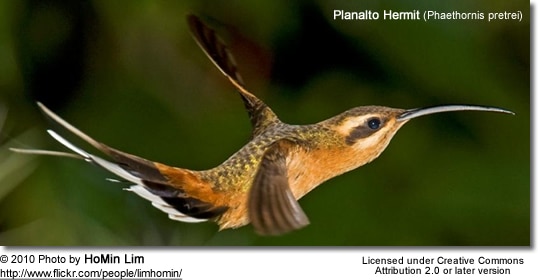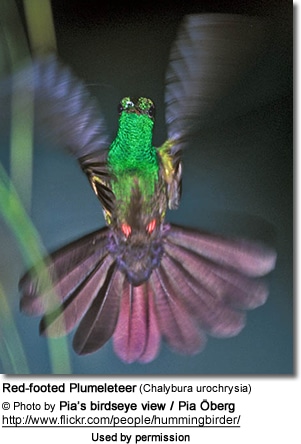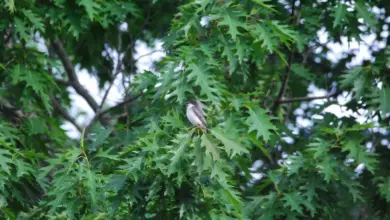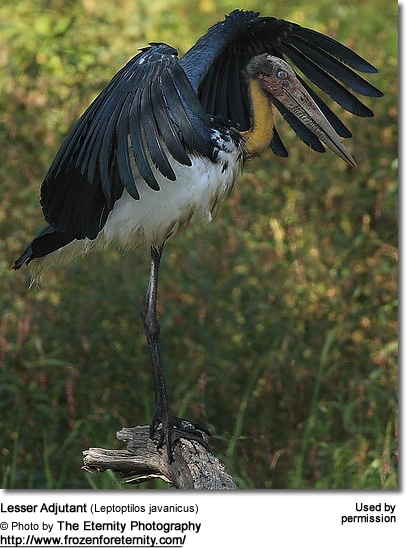Planalto Hermits
Hummingbird Information
The Planalto Hermits (Phaethornis pretrei) is a widespread and generally common South American hummingbird.
The Planalto Hermit is closely related and forms a superspecies with the Sooty-capped Hermit.
Distribution / Range
The Planalto Hermit occurs from north-east and south-central Brazil to eastern Bolivia, Paraguay, and marginally in north-western Argentina.
They are not commonly found in forest areas; but seem to prefer open and semi-open habitats, including scrubby areas, parks and gardens.
They are common in Caatinga (shrubland and thorn forest in northeastern Brazil), Cerrado (tropical savanna), and the Pantanal (tropical wetland located mostly in Mato Grosso do Sul in Brazil).
Description
This is a relatively large hermit.
It is usually easily recognized by its relatively large size. The underplumage and rump (lower back) are cinnamon-buff colored.
The central tail feathers are long and white-edged. The other tail feathers have broad white tips. The upper tail feathers are reddish.
Nesting / Breeding
Hummingbirds in general are solitary and neither live nor migrate in flocks; and there is no pair bond for this species – the male’s only involvement in the reproductive process is the actual mating with the female.
During the breeding season, the males of many Hermit species form leks (= competitive mating displays) and congregate on traditional display grounds. Once a female enters their territory, they display for her. Their display may entail wiggling of their tails and singing. Willing females will enter the area for the purpose of choosing a male for mating. Oftentimes she will choose the best singer.
He will separate from the female immediately after copulation. One male may mate with several females. In all likelihood, the female will also mate with several males. The males do not participate in choosing the nest location, building the nest or raising the chicks.
The female Planalto Hermit is responsible for building the remarkable cone-shaped nest which hangs by a single strong cable of spiders’ web from some overhead support, which could be a branch or the underside of the broad leaves of, for example, Heliconia plants, banana trees or ferns about 3 – 6 ft (1 – 2 m) above ground. However, these unusual nests have been found beneath bridges, in highway culverts and even hanging from roofs inside dark buildings. The nest is often near a stream or waterfall. It is constructed out of plant fibers woven together and green moss on the outside for camouflage in a protected location. She lines the nest with soft plant fibers, animal hair and feather down, and strengthens the structure with spider webbing and other sticky material, giving it an elastic quality to allow it to stretch to double its size as the chicks grow and need more room.
The average clutch consists of two white eggs, which she incubates alone, while the male defends his territory and the flowers he feeds on (although hermit males tend to be less aggressive than the males of other hummingbird species). The young are born blind, immobile and without any down.
The female alone protects and feeds the chicks with regurgitated food (mostly partially-digested insects since nectar is an insufficient source of protein for the growing chicks). The female pushes the food down the chicks’ throats with her long bill directly into their stomachs.
As is the case with other hummingbird species, the chicks are brooded only the first week or two, and left alone even on cooler nights after about 12 days – probably due to the small nest size. The chicks leave the nest when they are about 20 days old.
Diet / Feeding
The Planalto Hermits primarily feed on nectar taken from a variety of brightly colored, scented small flowers of trees, herbs, shrubs and epiphytes.
Hermits visit plants along a long route (in this case of up to 0.6 miles or 1 km) – a feeding technique that is commonly referred to as “trap-line feeding”. This differentiates them from most other hummingbird species which generally maintain feeding territories in areas that contain their favorite plants (those that contain flowers with high energy nectar), and they will aggressively protect those areas. They use their long, extendible tongues to retrieve the nectar while hovering with their tails cocked upward as they are licking at the nectar up to 13 times per second. Sometimes they may be seen hanging on the flower while feeding.
Many native and cultivated plants on whose flowers these birds feed heavily rely on them for pollination. The mostly tubular-shaped flowers actually exclude most bees and butterflies from feeding on them and, subsequently, from pollinating the plants.
They may also visit local hummingbird feeders for some sugar water, or drink out of bird baths or water fountains where they will either hover and sip water as it runs over the edge; or they will perch on the edge and drink – like all the other birds; however, they only remain still for a short moment.
They also take some small spiders and insects – important sources of protein particularly needed during the breeding season to ensure the proper development of their young. Insects are often caught in flight (hawking); snatched off leaves or branches, or are taken from spider webs. A nesting female can capture up to 2,000 insects a day.
Males establish feeding territories, where they aggressively chase away other males as well as large insects – such as bumblebees and hawk moths – that want to feed in their territory. They use aerial flights and intimidating displays to defend their territories.
Metabolism and Survival and Flight Adaptions – Amazing Facts
Species Research by Sibylle Johnson
Please Note: The articles or images on this page are the sole property of the authors or photographers. Please contact them directly with respect to any copyright or licensing questions. Thank you.

